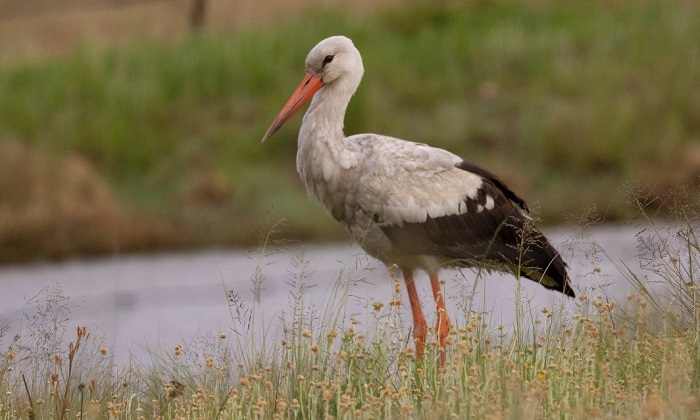Cover image: White Stork by Lance Robinson– Biesiesvlei, Free State – BirdPix No. 243136
Identification
The White Stork is a large and striking bird. It is conspicuous and unmistakable. The entire body is white with black flight feathers and a striking bright red bill and legs. The White Stork is unlikely to be confused with any other species. The sexes are alike.

Seekoeivlei Reserve, Free State
Photo by Ilse Hulme
Juveniles have black bills with a reddish base and dull brownish-red legs. The wing coverts and flight feathers are brownish-black.

Kromme River, Eastern Cape
Photo by Gregg Darling
Status and Distribution
The White Stork is, for the most part, a non-breeding Palearctic migrant to southern Africa. Most birds arrive in October and depart by May. A small number of birds breed in the southern parts of the Western Cape, from near Cape Town to Mossel Bay and Calitzdorp. These breeding birds are apparently resident.
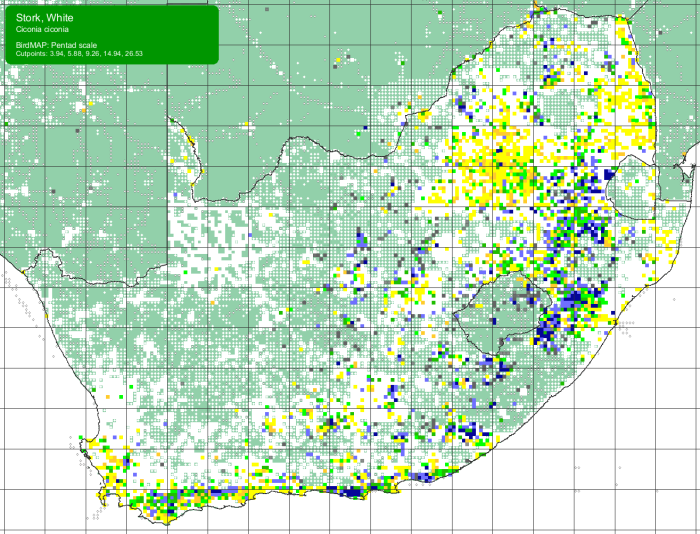
Details for map interpretation can be found here.
Palearctic birds breed from north Africa, western Europe and Scandinavia east to China. Winters are spent throughout sub-Saharan Africa. In southern Africa it occurs mainly in the eastern and extreme southern regions, with scattered records in the arid west. It generally avoids areas that receive less than 500mm of rain per year, except after periods of good rainfall.
The White Stork is common to abundant in southern Africa. Numbers vary greatly from year to year and are influenced by conditions elsewhere in Africa. Abundance is greatest when conditions are dry further north.
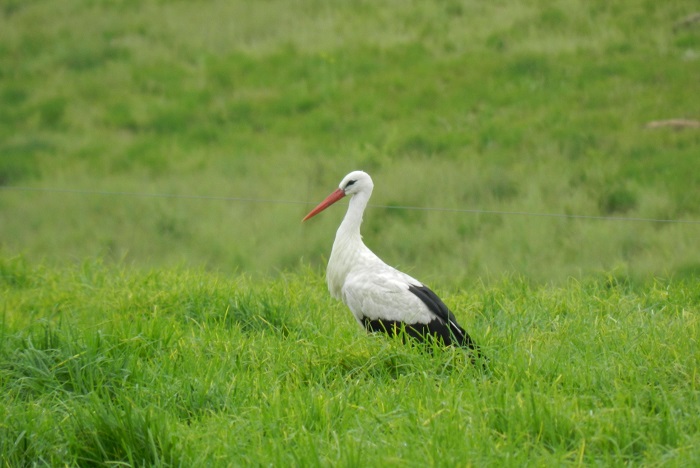
Ixopo District, KwaZulu-Natal
Photo by Malcolm Robinson
With one exception, the current distribution in southern Africa is probably unchanged from historical times. But its presence in the Western Cape is relatively recent, dating back to around the 1960s, after the establishment of agricultural croplands in the Overberg and Swartland regions east and north of Cape Town, respectively. The number of White Storks in the Overberg, east of Cape Town, is far larger than the number in the Swartland, north of Cape Town.
Through the 20th century, until the 1980s, the White Stork suffered a decline in its northern hemisphere breeding range, especially in western Europe. This trend has been reversed, and numbers are still increasing. It has never been considered to be globally threatened. The main threats to the species are from habitat loss, collisions with overhead power lines, pesticide contamination and hunting.
Habitat
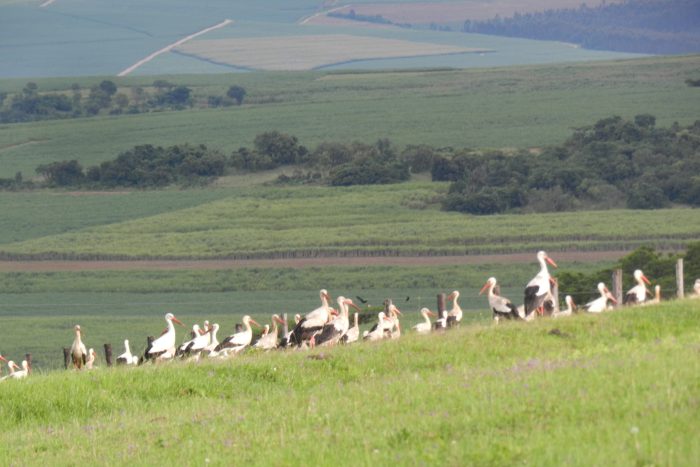
Wartburg district, KwaZulu-Natal
Photo by Malcolm Robinson
White Storks inhabit a variety of open habitats including grasslands, open woodland, seasonal wetlands, agricultural crop fields and pastures. It is estimated that as much as 86% of birds in South Africa are found on croplands and pastures. Arid and semi-arid vegetation types in the west are generally avoided except in years of above average rainfall. However, the White Stork is common in the grass dominated eastern fringes of the Nama-Karoo. The White Stork drinks regularly and is often found around dams and wetlands but is not dependent on aquatic habitats.

Bakubung, North West
Photo by Pieter Cronje
Behaviour
The White Stork usually occurs in flocks numbering 10 to 50 birds, but sometimes congregates in the thousands or even tens of thousands. They may gather in groups near water around midday. Sometimes rests standing on 1 leg, with its bill buried in the neck feathers. This posture is thought to minimise heat loss. As with other storks they cool themselves down in hot weather by defecating on their legs. White Storks roost gregariously in trees or at shallow wetlands, sometimes alongside Abdim’s Storks. Travels in large flocks, circling on thermals to gain height. Flies with the neck and legs fully extended.
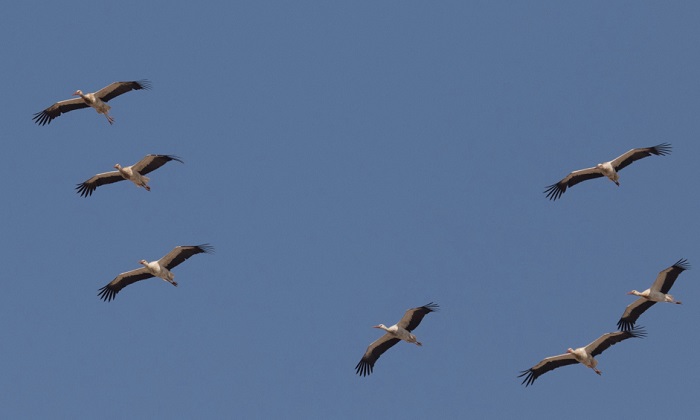
Hwange National Park, Zimbabwe
Photo by Derek Solomon
White Storks usually forage in well-spaced groups. It is estimated that as many as 20 000 birds can gather at locust irruptions in the Karoo. Walks slowly and steadily, searching for prey. They regularly follow large game animals and domestic cattle in order to capture flushed insects.
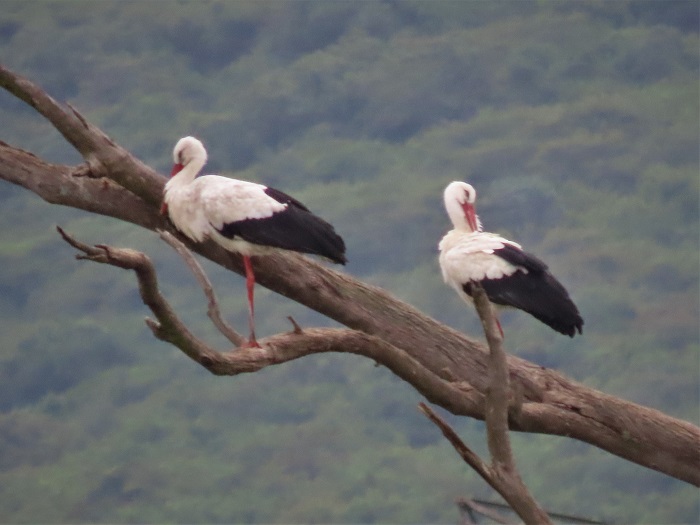
Mgeni River, KwaZulu-Natal
Photo by Malcolm Robinson
The White Stork is predatory, and feeds on a wide range of small animal prey. It consumes agricultural pests, including Bollworms (Heliothis armigera), Armyworms (Spodoptera exempta) and Brown Locusts (Locustana pardalina). It also eats mice, small reptiles (snakes and lizards), amphibians, fish, molluscs, various large insects, the young of ground-breeding birds, scorpions, caterpillars and termite alates. Indigestible food material is regurgitated in the form of pellets.
Its breeding behaviour is little known in South Africa, but is probably similar to that in Europe, Asia and north Africa. Breeding has been recorded from September to November in South Africa. In 2024, we are making a determined effort to find out just how many pairs are breeding in South Africa. Read about this initiative here. If you know of a nest, or find one, please let us know (ring@thebdi.org).
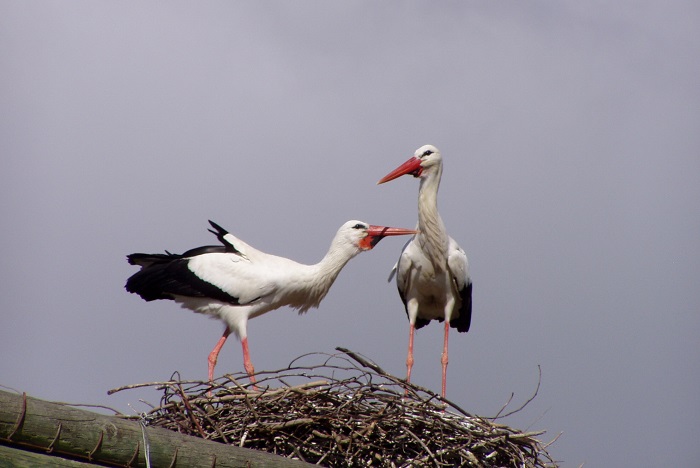
A nest at the former Tygerberg Zoo, Western Cape
Photo by Les Underhill
White Storks are monogamous. The nest is a large platform of sticks, reeds, clods of earth and grass. The nest is built quickly, by both sexes in as little as 8 days. The majority of nesting material is contributed by the male and nest material is added periodically throughout the breeding cycle. Nests are placed up to 13m above the ground, in a tree or broken chimney etc. Nests are regularly added to and re-used, but not every year, and the nest gradually increases in size over time.
One to six dull white eggs are laid per clutch. Incubation duties are shared by both sexes and incubation lasts for around 30 days. Incubation begins once the first egg has been laid, resulting in the eggs hatching asynchronously. The newly hatched young are covered with sparse creamy-white down, becoming dense, white and woolly as they grow.
The young are brooded, fed and cared for by both parents. Fledged birds remain dependent on their parents for up to 20 days after leaving the nest.
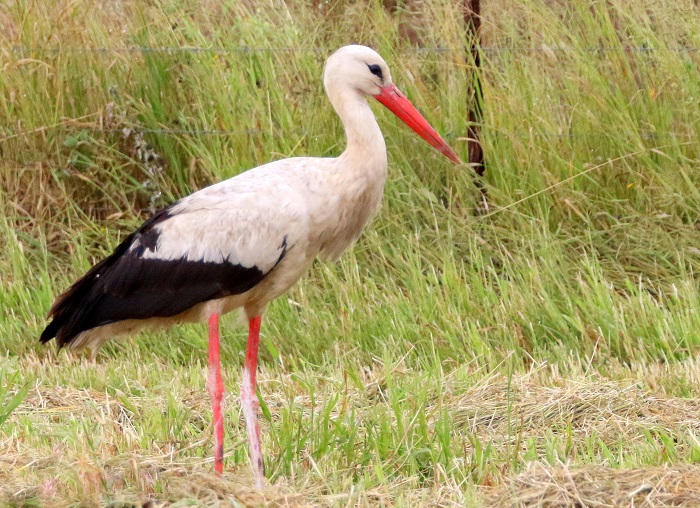
Kgomo-Kgomo flood plain, North West
Photo by Lia Steen
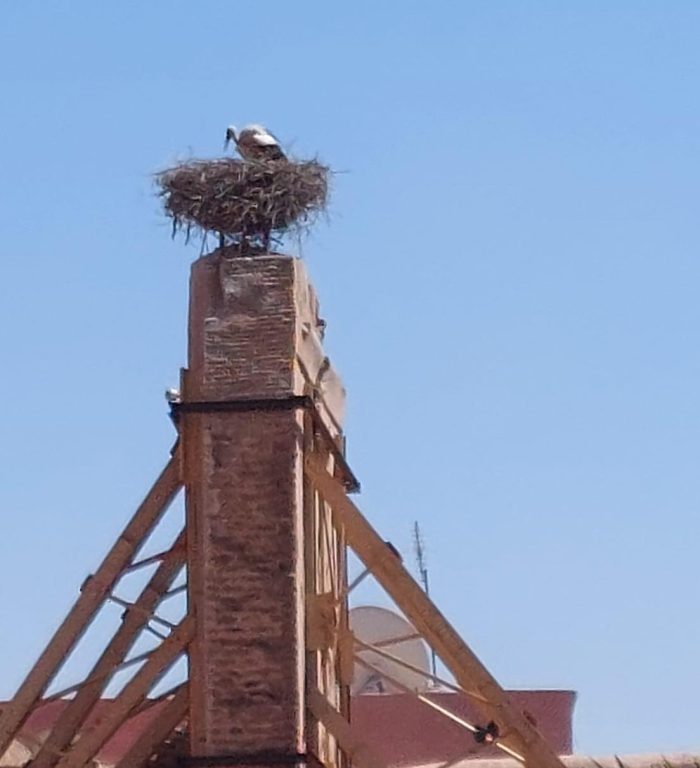
Further Resources for the White Stork
Species text in the first Southern African Bird Atlas Project (SABAP1), 1997.
The use of photographs by Garth Aiston, Gerald Wingate, Gregg Darling, Michael Wright, Phillip Nieuwoudt, Tino Herselman and Zenobia van Dyk is acknowledged.
Virtual Museum (BirdPix > Search VM > By Scientific or Common Name).
Other common names: Witooievaar (Afrikaans); uNogolantethe, uNowanga (Zulu); Ingwamza (Xhosa); Gewone Ooievaar (Dutch); Cigogne blanche (French); Weißstorch (German); Cegonha-branca (Portuguese)
List of species available in this format.
Recommended citation format: Tippett RM 2024. White Stork Ciconia ciconia. Biodiversity and Development Institute. Available online at https://thebdi.org/2024/03/14/white-stork-ciconia-ciconia/

Wartburg district, KwaZulu-Natal
Photo by Malcolm Robinson

